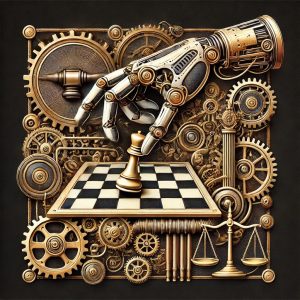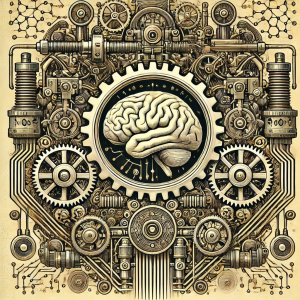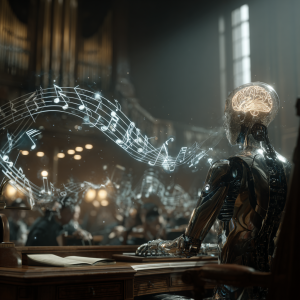If you´ve ever heard about the term machine learning (ML) and immediately pictured robots plotting world domination – take a deep breath. The truth is far less terrifiying (and much more usefull). ML isn´t about sentient machines; it´s about teaching computers to recognize patterns, make predictions and improve over time.
Think of it like this: If AI were a lawyer, ML would be the diligent intern constantly reviewing case files, learning from past rulings, and refining its understanding of legal arguments. It doesn´t come up with laws or make grand ethical judgments, but it does process massive amounts of data at lightning speed – something that´s already transforming industries, including law. But how does it actually work? And why should you and me care? Grab your coffee (or tea), and let´s break it down in a way that won´t make your head spin.
Wait ... Machines can learn?
Yep, they can! But not in the „sit in a classroom, take notes and daydream“ kind of way. Machine learning is more like training a dog – exept the dog is a computer and instead of treats, we reward it with better accuracy.
At its core, ML is about teaching computers to recognize patterns in data. The more data we feed them, the smarter they get. Think of it like this: A baby sees a dog for the first time. Cute! The baby sees a different dog. Also cute. Over time, the baby learns: Four legs, fluffy, wags tail = dog!
ML works in a similar way – exept instead of looking at puppies, it analyzes emails, contracts, legal documents or even medical scans to make predictions and decisions.
For instance, imagine you´re training an ML model to detect fraudulent contracts. First, you provide it with
thousands of labeled images of cats and non-cats. Over time, it would identify patterns—such as fur, ears, or shape—and use those to make predictions about new, unseen images.
How Does Machine Learning Actually Work?
At its core, machine learning is all about finding patterns in data and making predictions. It starts with a dataset – this could be anything from legal contracts to customer complaints. The machine then processes this data using mathematical models, identifiying relationships and trends that humans might miss. The real magic happens when the system improves over time: it adjusts its internal parameters based on feedback, refining its predictions with each new piece of information.
For instance, imagine you´re training an ML model to detect fraudulent contracts. First, you provide it with thousands of past contracts labeled as „fraudulent“ or „legitimate“ – this is the training phase. The model analyzes patterns, like unusual clauses, inconsistencies or hidden risks. Once trained, it can scan new contracts and flag potential fraud based on what it has learned. Over time, as it processes more cases and recieves corrections, it becomes even more accurate – just like a junior associate gaining experience.
This ability to learn from data, adapt and improve without explicit programming is what makes ML so powerful – and why it´s transforming industries, including law.
The Three Types of Machine Learning
1. Supervised Learning: The Straight-A Student
In supervised learning, we give the machine examples with correct answers. It´s like giving a student a math workbook with the answers.
Example: Ever wonder how your email filters spam? It´s because an ML model was trained on thousands of emails labled as „spam“ or „not spam„. Now, when a suspicious email arrives, the system can say „Ah-ha! I´ve seen this pattern before – this smells like spam.“

2. Unsupervised Learning: The Independent Thinker
This one is different – no answer key! The machine just gets a bunch of data and has to find patterns on its own.
Example: Imagine your law firm gets thousands of client complaints. Instead of reading every single one, ML can group them into topics – billing issues, delays or „I just do not like my lawyer“. Suddenly, patterns emerge and you know where to focus.

3. Reinforcement Learning: The Trial-and-Error Genius
This is like teaching a dog to do tricks. The machine tries something, gets feedback (reward or punishment) and improves over time.
Example: Self-driving cars use reinforcement learning to figure out how to drive. At first, they make mistakes (oops, hit a cone!), but over time, they learn the best moves – just like a human driver.

Why Should Lawyers Care about ML?
You might be thinking, „This is cool, but I´m not building an AI startup – why should I care?“ Well, my friend, ML is already shaping the futur of law, with or without you.
- Contract Review? Automated. ML can scan thousands of contracts in seconds, spotting risks, missing clauses or unfavorable terms
- Predicting Case Outcomes? You bet. Some ML models analyze past cases to predict how likely you are to win or lose in court
- Legal research? AI´s got your back. Instead of searching for hours, ML-powered tools can find relevant case law instantly
So yeah, ML isn´t replacing lawyers – but it is making life a whole lot easier.

Final Thoughts
Machine learning is like a really smart intern – it learns from experience, gets better over time and helps with all the tedious tasks nobody wants to do.
And the best part? You don´t need to be a tech genius to use it. The legal industry is already adopting ML-powered tools and the sooner you get familiar with them, the better prepared you´ll be for the AI-powered future.
Stay curious, stay informed, and let´s keep exploring the fascinating world of AI together.
This post was written with the help of different AI tools.
Recommended Read:
Disclaimer: The links provided on this blog lead to external websites that are not under my control. I do not guarantee the accuracy, or the content of those sites. Visiting these sites is at your own discretion and risk.




